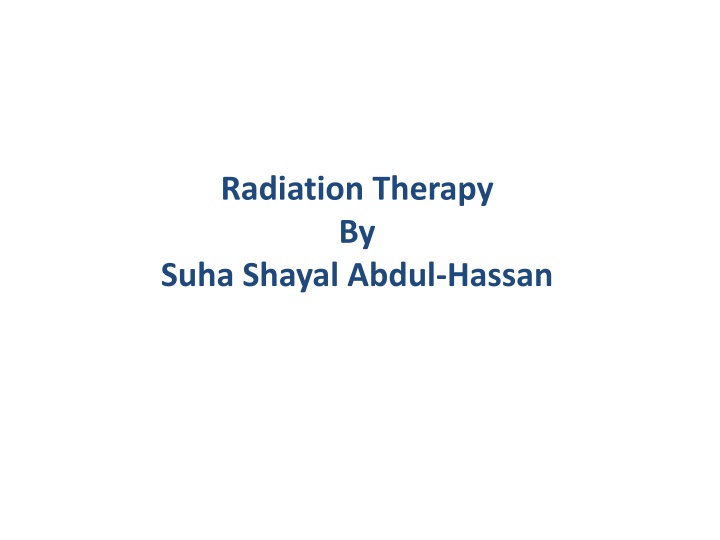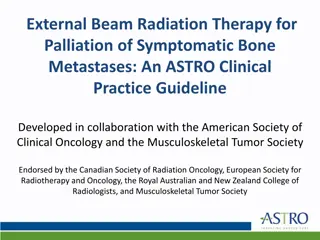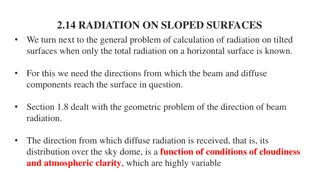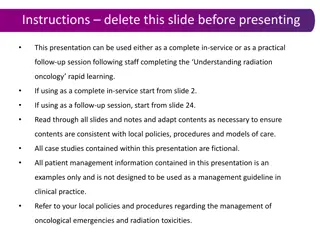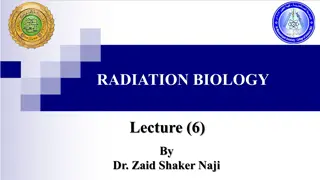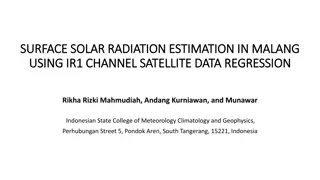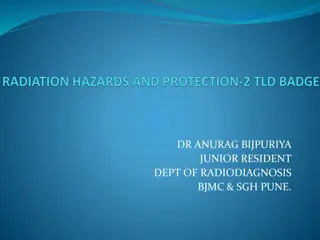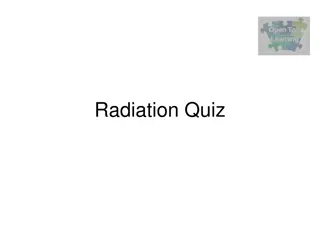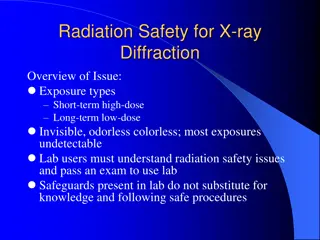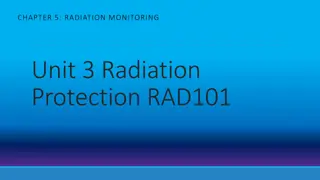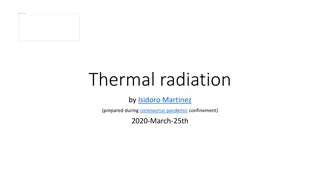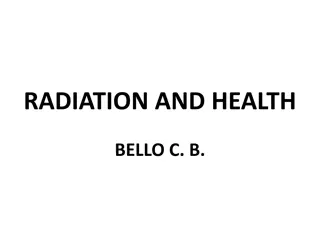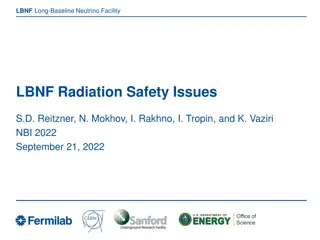Radiation Therapy
Radiation therapy is a vital tool in cancer treatment, aiming to maximize tumor damage while minimizing harm to normal tissue. Different methods are used, such as surgery, radiation therapy, and chemotherapy drugs. The success of radiotherapy depends on factors like cancer type, the skill of the radiotherapist, radiation type, and accuracy in delivering radiation to the tumor. It's crucial to balance the radiation dose carefully to avoid complications.
Download Presentation

Please find below an Image/Link to download the presentation.
The content on the website is provided AS IS for your information and personal use only. It may not be sold, licensed, or shared on other websites without obtaining consent from the author.If you encounter any issues during the download, it is possible that the publisher has removed the file from their server.
You are allowed to download the files provided on this website for personal or commercial use, subject to the condition that they are used lawfully. All files are the property of their respective owners.
The content on the website is provided AS IS for your information and personal use only. It may not be sold, licensed, or shared on other websites without obtaining consent from the author.
E N D
Presentation Transcript
Radiation Therapy By Suha Shayal Abdul-Hassan
Radiation therapy is recognized as an important tool in the treatment of many types of cancer. Three major methods are used alone or in combination to treat cancer: surgery, radiation therapy, and drugs (chemotherapy) The success of radio therapy depends on: The type & extent of the cancer. The skill of the radiotherapist, the physician who specializes in the treatment of cancer with radiation. The kind of radiation used in treatment. The accuracy with which the radiation is administrated to the tumor.
* Because of the possibility of radiation induced cancer, it is generally safer to use other types of treatment when it possible. Too, little radiation does not kill the tumor; too much can produce serious complication in normal tissue The dose units used in radiotherapy Erythematic dose: Is the quantity of X rays that cause a reddening of the skin, it is used in very early days of radiation therapy. Dose: it's the quotient of the absorbed energy of radiation by unit mass of medium D= / m Dose: defined as 100 ergs/gram. That is, a radiation beam that gives 100 ergs of energy to 1 gram of tissue gives the tissue an absorbed dose of 1 rad.
Rad: unit used to measure the quantity absorbed dose. it is defined as a radiation beam that gives 100 ergs of energy to 1g of tissue ( 1 rad=100 ergs/g) can be used for any type of radiation in any material Gray can be used for any type of radiation in any material D= / m =1 joule/kg= 1 Gray 1 Gray = 100 rad Roentgen : a unit based on ionization in air, it is defined only for X-rays & rays in air that produce charge equal to 2.5 104coulomb/kg . 1R= 2.5 104coulomb/kg air 1R = 0.87 Gray = 87 Rad
Exposure: it is the quotient of Q by m. where: Q: is the sum of both signs of charge produce by Ionization of certain volume of air by X-ray & rays m : mass of air. X = Q/ m =Colum/Kgm (Roentgen) (R) X = X/T R/Sec (exposure rate) An exposure of 1R would result in nearly 1 rad of absorbed dose in soft tissue(water). At the energies used in diagnostic radiology the ratio of rads to roentgens in bone is about 4,that is ,1R exposure results is about 4 rads of absorbed dose. At the high energies used in modern radiotherapy the ratio the rads to roentgens is nearly 1 for bone and soft tissue.
Principles of radiation therapy: The basic principle of radiation therapy is to maximize damage to the tumor while minimizing damage to normal tissue. Factors that determine how much radiation is required are The type of radiation The type of cells. The environment of the cells, for example ,its blood and oxygen supplies. Also the nucleus of the cell is more sensitive to the radiation than the surrounding cytoplasm
Relative biological effect( RBE) : Some of type of radiation are more effective in killing cells or have a higher relative biological effect. RBE : is the ratio of the number of gray of 180-250 KeV X rays needed to produce a given biological effect to the number of grays of test radiation needed to produce the same effect. LD50 : The quantity of radiation that will kill half of the organisms in population is called the lethal dose for 50% or LD50 The Oxygen enhancement of radiation effect : Gray noticed that cells irradiated in the present of oxygen were much easier to kill than cells of the same type irradiated without oxygenate.
In the presence of molecular oxygen (O2)cells are more sensitive to X & -rays than when they are irradiated at very low levels of oxygen (hypoxia). Oxygen modifies the quantitative amount of radiation damage, but does not alter it qualitatively. It merely reduces the dose of radiation required to give certain radiobiological effect. The oxygen enhancement ratio ( OER ) is the ratio of the dose of radiation required to give an effect under hypoxia conditions to the dose needed to give the same effect under oxygenated conditions . OER . is between 2 & 3 for most biological systems
Requirement for Radiotherapy: 1. Determination of the tumor by accurate diagnosis. 2. Determination the quantity & quality of radiation required for radiotherapy. 3. Dose fractionating. 4. Dose diving. 5. Oxygen enhancement (or other sensitizers) to in crease killing of tumor cells. 6. Prohibitive to reduce killing in the healthy cells. 7. Bragg peak calculation. Bragg Peak: As an individual charged particle gives up its energy & slows, the value of LET increases & reaches a maximum just before the particles loses its ability to ionize. The region of increased ionization seen near the end of a particle beam is known as a Bragg peak.
Factors affecting radiosensivity: 1. Biological factors: i. Proliferate state of the cells. ii. The phase of the cell cycle at irradiation. iii. The presence of biological repair capacity(some type of cells have greater capacity for repair than other). iv. The Sex of the biological v. The age. (humans are most sensitivity before birth then decreases until maturity. In old age humans again become more radiosensitive). vi. The species differences(if the patient suffering from malignant disease or other type of tumor).
2. Physical Factors: Dose & dose rate of radiation If a dose of radiation is delivered over a long period of time rather than quickly, the effect of than dose will be less. Dose fractionating. Is less effective because tissue repair and recovery occur between doses. Linear energy transfer of radiation. LET. Linear energy transfer (LET ): LET is a measure of rate at which energy is transferred from ionizing radiation to soft tissue. It has units of keV of energy transferred per micrometer of track length in soft tissue (keV/ m).
The ability of ionizing radiation to produce a biologic response increases as the LET of radiation increases. The LET of diagnostic X-rays is about 3 keV/ m, which is relatively low among all Since the biological effectiveness of particle related to amount of ionization, thus particle high LET will be more damage than low LET. 3. Chemical factors: Rediosensitizers (Halogenated pyrimidine & Oxygen ). Radioprotectores e.g. Sulphdry1 group (sulfur and hydrogen bound together) such as cysteine and cysteamine.
1. Delay in the onset of DNA synthesis. 2. Reduction in the amount of DNA synthesis. 3. The inhibition of the flow of cells through S phase of the cell cycle. 4. Strand breakage & nitrogenous base disruption. 5. Chromosomes damage & changes in the genetic material which leads to "mutations 6. Killing of DNA i.e. killing the cell. Dose of Several grays can cause:
Effect of Radiation on Tissues: The radio sensitivity of tissue is directly proportional to its mitotic activity & inversely proportional to its state of differentiation. It is the process of mitosis that radio sensitivity & it is that fact which confers sensitivity on rapidly dividing cells populations such as skin, bone marrow , & gonads. In contrast , tissues that contain few dividing cells such as the neurons, kidny are termed radio resistance.
Effect of Radiation on caner: A cancer (or tumor) is a group of cells that divides to give loosely organized. Cancer cells are relatively independent of the normal control mechanisms of the body. Radiation can cure cancer but also can induce cancer. The cells near the center of large tumor have a poor blood supply. When the tumor irradiated the healthy cancer cells with a good blood supply are killed and many of the more poorly oxygenated, radio resistant tumor cells remain alive, that makes them more difficult to cure.
* Normal tissues are usually fully oxygenate means that a great number of normal cells than tumor cells will be killed The methods to reduce this effect include the use of: i. high pressure O2. Hyperbaric (high pressure ) oxygen has been used in radiation therapy in an attempt to increase the radio sensitivity of nodular, vascular tumors. ii. Tourniquet hypoxia. iii. high LET radiation.
